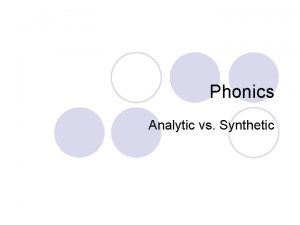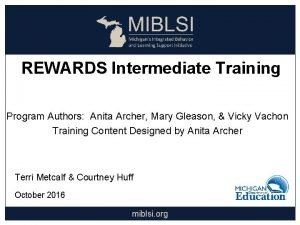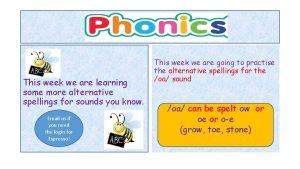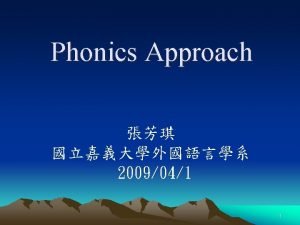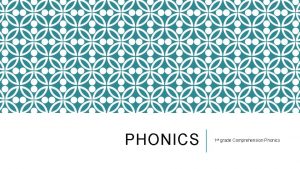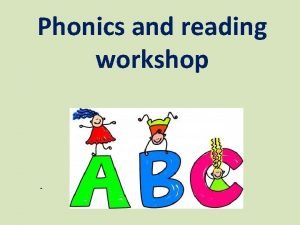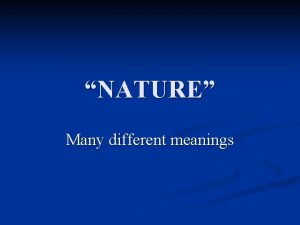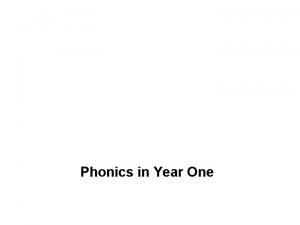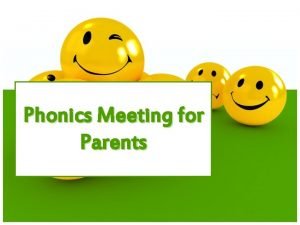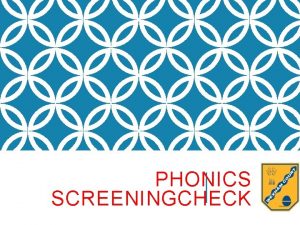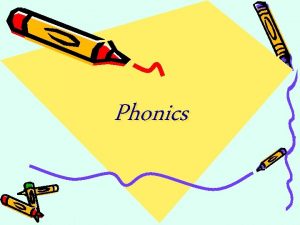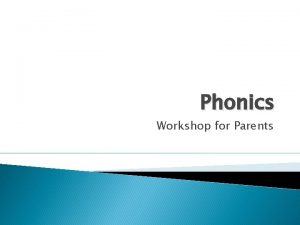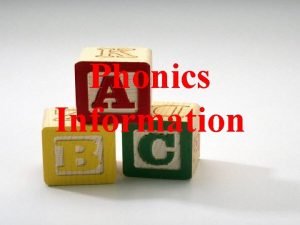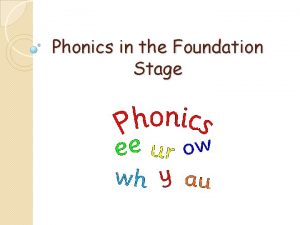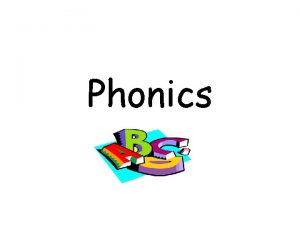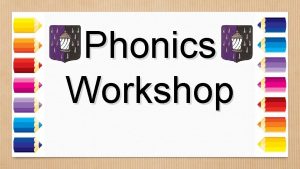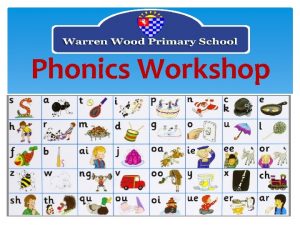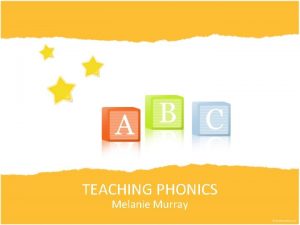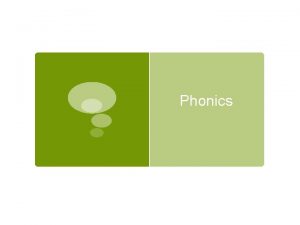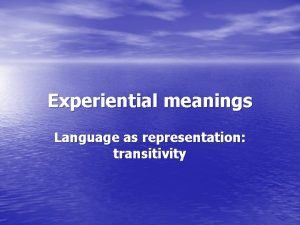Phonics Approach for Reading Phonics two meanings 1
































































- Slides: 64


Phonics Approach for Reading Phonics, two meanings 1. An approach, for teaching reading 2. (We say, “Based on the Phonics Approach… 3. 2. The letter-sound relationships 4. (We say, “Teach phonics…. ”) 2

Stages of Reading Development Stage 0: Birth to Age 6 Prereading: 1. Develop knowledge of print 2. Recognize a few letters, words, and environmental print signs 3

Stages of Reading Development Stage 1: Grades 1 through 2 Initial reading or decoding: 1. Develop the understanding of the alphabetic principle 2. Begin to decode words 4

Stages of Reading Development Stage 3: Grades 2 through 3 Confirmation, fluency: 1. Develop strategies to decode words and make meaning from text 2. Recognize many words by sight 3. Sound out words they don’t recognize by sight 5

Stages of Reading Development Stage 3: Grades 4 through 8 Learning the new: Use reading more as a way to obtain information and learn about the values, attitudes, and insights of authors. 6

Phonics knowledge to be covered Kindergarten 1. Concepts of print 2. Alphabet recognition 3. Phonemic awareness 4. Blending 5. Sense of story 6. Building world knowledge 7

Phonics knowledge to be covered Grade 1 1. Phonemic awareness 2. Blending and word building 3. Short vowels (CVC patterns) 4. Consonants 5. Final e (a_e, e_e, i_e, o_e, u_e) 6. Long-vowel diagraphs (ai, ay, ea, ee) 8

Phonics knowledge to be covered Grade 1 7. Consonant clusters (bl, cr, st) 8. diagraphs (sh, ch, th, wh) 9. Some other vowels (oo, ou, ow, oi) 10. Early structural analysis: verb endings (-ed, -ing); plurals, contractions (I’m, don’t) compound words (daydream) 9

Phonics knowledge to be covered Grade 1 11. Connected text reading 12. Vocabulary development/world knowledge 10

Phonics knowledge to be covered Grades 2 -3 1. Grade 1 skills review 2. More complex vowel spellings 3. More structural analysis (compound 4. words, affixes, etc. ) 5. 4. Multisyllabic words 11

Phonics knowledge to be covered Grades 2 -3 5. connected text reading 6. Vocabulary development/world knowledge 12

Phonics knowledge to be covered Grades 4 -8 1. More complex vowel spellings 2. More structural analysis (compound 3. words, affixes, etc. ) 4. 3. Multisyllabic words 5. 4. Syllabication strategies 6. 5. Word origins (Greek and Latin root 13

Phonics knowledge to be covered Grades 4 -8 6. connected text reading 7. Vocabulary development/world knowledge 14

Our focus on Phonics Workshop Grades 1 through 3 for native speakers That is about Grades 1 through 6 for Taiwanese EFL learners (repeat the phonics knowledge…) 15

What to cover in our Phonics instruction? Basic Phonics: build vocabualry develop phonological awareness learn letter-sound correspondences 16

Basic Phonics: learn letter-sound correspondences 1. one on one B-/b/ 2. Short vowel (CVC) 3. Final e (CVCe) 4. Long vowel diagraph (CVVC; ai, ay, ee, ea) 17

Basic Phonics: learn letter-sound correspondences 5. Consonnat cluster (fl, bl, st) 6. Consonant daigraph (sh, th, wh) 18

Suggestions for Instruction 1. Short-vowel sounds before long… 2. esp. CVC 3. 2. Provide decodable connected text 4. for applying their knowledge of 5. learned sound-spelling relationships 6. e. g. The fat cat is on the mat. (more. 19

Suggestions for Instruction 3. Teach continuous consonants first e. g. f l m n r s --when blending, sounds can be sustained without distortion --go from slow blending to fast blendin 20

Suggestions for Instruction 4. Progress from simple to more complex sound-spellings. --consonants before diagraphs (ch th wh ph) and blends (bl- cr -st) --short vowel sound-spelling before long vowel sound spelling, variant vowels and diphthongs (ou, oi) 21

Advanced Phonics: 1. Some other vowels (oo, ou, ow, oi) 2. spelling patterns (-ack, -eam, fl) 3. Early structural analysis: verb endings (-ed, -ing); plurals, contractions (I’m, don’t) compound words (daydream) 22

Advanced Phonics: letter-sound correspondences 4. More complex vowel spellings (-oil, -ouch) 5. More structural analysis (compound words, affixes, etc. ) 6. Multisyllabic words 7. Syllabication strategies 23

For today 1. Basic Phonics 2. 2. Advanced Phonics 3. 3. Lesson plans 24



Phonics for reading comprehension Meaningful sound input (口語詞彙) Phonological awareness (音韻覺識) Letter-sound correspondences (字母名—字母音對應) 27


4. 音韻覺識的發展 語音結合(blending) for reading 語音拆解(segmenting) for spelling 29





孩童的拼字發展過程 Prephonic Spelling Children experiment with prephonic spelling when they use writing such as letters, numbers and other symbols to represent written language as they explore the relationships between written and spoken words. 34

Prephonic Spelling For example, The drawing of car for “car” The drawing of a heart for “heart” 35

Semi-Phonetic Spelling In semi-phonetic spelling there is a beginning understanding of sound-symbol relationships. A word may be represented with one letter or two. e. g. B, BD (bed) KR, TL 36

Phonetic Spelling In phonetic spelling, writers record words using an almost perfect match of letters and sounds. Particular spelling of sounds can occur in a self-formulated style of spelling. e. g. sbring, sdudent 37

Activities 1. My teaching on Picky Nicky 2. Scan your textbooks 38

Advanced Phonics 1. Ways to Teach Phonics 2. What to Be Taught Are…. 3. Word Study 39

1. Ways to Teach Phonics Two ways to teach phonics 1. Direct phonics or explicit phonics 2. (synthetic approach) 3. 2. Indirect phonics or implicit phonic 4. (analytic approach) 40

Direct phonics A bottom-up model of learning to read: • • Teach letter names Teach letter sounds Teach blending sounds Provide opportunities to blend words in context 41

Indirect Phonics A “discovery method” Learners are asked to deduce the sound-spelling relationship. 42

Indirect Phonics Instruction roughly follows this sequence: 1. A list of words with a common 2. phonic element is shown. For exampl 3. sun son set sing mite bite site 43

Indirect Phonics Instruction roughly follows this sequence: 2. Learners are asked to discover what they have in common, focusing on finding a similar sound. 44

Indirect Phonics Instruction roughly follows this sequence: 3. Once the common sound is discovered, the spelling that stands for the sound is discussed. 45

Indirect Phonics Instruction roughly follows this sequence: 4. Learners are asked to verbalize a generalization about the sound and the spelling, such as “the letter s stands for the /s/ sound. 46

2. What to be taught are… 1. More consonant clusters 2. Rimes (-ack; -all) (including diphthongs: -oil; -ouch) 3. High frequency words (sight words) either decodable, e. g. had make or un-decodable, e. g. the your 47

Suggestions for Instruction— Advanced Phonics Once complex sound-spellings have been taught, focus on larger spelling patterns and useful word parts. e. g. prefixes, suffixes, and roots 48

2. What to be taught are… 4. Teach syllabification To decode multisyllabic words, learners must be able to divide words into recognizable chunks. 49

What is a syllable? A syllable is a unit of pronunciation. (Look at the mirror for the drops of jaw or the openings of the mouth for a vowel. ) 50

Syllabication To be able to divide words into syllables, they need to a. figure out the vowel sound in oneb. syllables words c. b. know that one syllable has only d. one vowel sound 51

Six basic syllable spelling patterns 1. closed: The syllable ends in a 2. consonant. e. g. cat at rabbit 2. open: The syllable ends in a vowel (usu. a long vowel). e. g. eye tie tomato [tə meto] 52

Six basic syllable spelling patterns 3. vowel-silent e (VCe) (usu. a long vowel) e. g. cake compete decide 4. vowel team: vowel diagraphs e. g. boat explain outch 53

Six basic syllable spelling patterns 5. r-controlled: when a vowel is followed by r, the letter r affects the sound of the vowel. bird turtle work (*car) 54

Six basic syllable spelling patterns 6. consonant + le: Usually when le appears at the end and is preceded by a consonant, the consonant + le form the final syllable. little circle 55

Suggestions for Instruction— Advanced Phonics # Provide phonics generalizations e. g. 1) When the letter c comes before e, i , or y in a word, it usually represents the /s/ sound. (e. g. cent, city, cycle). ……. . 56

Suggestions for Instruction— Advanced Phonics # Teach blending multisyllabic words e. g. unhappy: 1) Tell ss to first look for larger word parts within this long word. 2) Point to the prefix un and say its sounds -/un/. Then point to the word happy. 57

Suggestions for Instruction— Advanced Phonics # Teach blending multisyllabic words e. g. unhappy: 3) Slowly put together these two word parts─un and happy─to say the word unhappy. 4) Circle the word with your finger and say, “The word is unhappy. ” 58

Suggestions for Instruction— Advanced Phonics # Teach blending multisyllabic words e. g. unhappy: 5) Explain to students how the word parts also help you determine the meaning of the word. 59

Advanced Phonics/Word Study For those students who have mastered phonics and sound-symbol relationships, how can orthographic awareness be used to further develop their reading and writing abilities? 60

3. Word Study Refers to the body of knowledge that includes phonics and spelling. Word study involves a range of instructional activities and experiences that a teacher designs to support children’s development of wordsolving skills. 61

3. Word Study (Structural analysis) 1. Compound words 2. Prefixes 3. Suffixes 4. (plurals and inflectional endings) 5. 4. Homophones 62

Question and Discussion 63

Lesson Plans? Drilling activities only? Classroom activities on three basic components of Phonics instruction? 64
 Synthetic and analytic
Synthetic and analytic While reading activities
While reading activities Phonics for reading anita archer
Phonics for reading anita archer Ash's phonics
Ash's phonics Formuö
Formuö Typiska drag för en novell
Typiska drag för en novell Nationell inriktning för artificiell intelligens
Nationell inriktning för artificiell intelligens Ekologiskt fotavtryck
Ekologiskt fotavtryck Varför kallas perioden 1918-1939 för mellankrigstiden?
Varför kallas perioden 1918-1939 för mellankrigstiden? En lathund för arbete med kontinuitetshantering
En lathund för arbete med kontinuitetshantering Särskild löneskatt för pensionskostnader
Särskild löneskatt för pensionskostnader Tidbok för yrkesförare
Tidbok för yrkesförare A gastrica
A gastrica Förklara densitet för barn
Förklara densitet för barn Datorkunskap för nybörjare
Datorkunskap för nybörjare Stig kerman
Stig kerman Hur skriver man en tes
Hur skriver man en tes Magnetsjukhus
Magnetsjukhus Nyckelkompetenser för livslångt lärande
Nyckelkompetenser för livslångt lärande Påbyggnader för flakfordon
Påbyggnader för flakfordon Tryck formel
Tryck formel Svenskt ramverk för digital samverkan
Svenskt ramverk för digital samverkan Jag har gått inunder stjärnor text
Jag har gått inunder stjärnor text Presentera för publik crossboss
Presentera för publik crossboss Argument för teckenspråk som minoritetsspråk
Argument för teckenspråk som minoritetsspråk Vem räknas som jude
Vem räknas som jude Klassificeringsstruktur för kommunala verksamheter
Klassificeringsstruktur för kommunala verksamheter Mjälthilus
Mjälthilus Bästa kameran för astrofoto
Bästa kameran för astrofoto Cks
Cks Byggprocessen steg för steg
Byggprocessen steg för steg Bra mat för unga idrottare
Bra mat för unga idrottare Verktyg för automatisering av utbetalningar
Verktyg för automatisering av utbetalningar Rutin för avvikelsehantering
Rutin för avvikelsehantering Smärtskolan kunskap för livet
Smärtskolan kunskap för livet Ministerstyre för och nackdelar
Ministerstyre för och nackdelar Tack för att ni har lyssnat
Tack för att ni har lyssnat Vad är referatmarkeringar
Vad är referatmarkeringar Redogör för vad psykologi är
Redogör för vad psykologi är Stål för stötfångarsystem
Stål för stötfångarsystem Atmosfr
Atmosfr Borra hål för knoppar
Borra hål för knoppar Vilken grundregel finns det för tronföljden i sverige?
Vilken grundregel finns det för tronföljden i sverige? Formel standardavvikelse
Formel standardavvikelse Tack för att ni har lyssnat
Tack för att ni har lyssnat Steg för steg rita
Steg för steg rita Vad är verksamhetsanalys
Vad är verksamhetsanalys Tobinskatten för och nackdelar
Tobinskatten för och nackdelar Blomman för dagen drog
Blomman för dagen drog Modell för handledningsprocess
Modell för handledningsprocess Egg för emanuel
Egg för emanuel Elektronik för barn
Elektronik för barn Plagg i gamla rom
Plagg i gamla rom Strategi för svensk viltförvaltning
Strategi för svensk viltförvaltning Kung som dog 1611
Kung som dog 1611 Indikation för kejsarsnitt på moderns önskan
Indikation för kejsarsnitt på moderns önskan Sju för caesar
Sju för caesar Tack för att ni lyssnade
Tack för att ni lyssnade Matte större än tecken
Matte större än tecken Dikt med fri form
Dikt med fri form Inköpsprocessen steg för steg
Inköpsprocessen steg för steg Rådet för byggkompetens
Rådet för byggkompetens Ledarskapsteorier
Ledarskapsteorier Kolposkopi, px
Kolposkopi, px Myndigheten för delaktighet
Myndigheten för delaktighet
